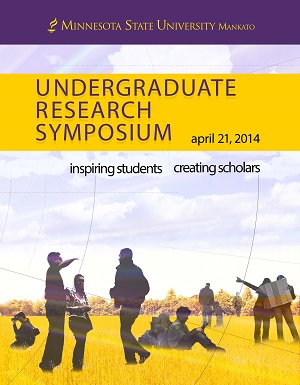Location
CSU Ballroom
Start Date
21-4-2014 10:00 AM
End Date
21-4-2014 11:30 AM
Student's Major
Chemistry and Geology
Student's College
Science, Engineering and Technology
Mentor's Name
John Thoemke
Mentor's Email Address
john.thoemke@mnsu.edu
Mentor's Department
Chemistry and Geology
Mentor's College
Science, Engineering and Technology
Description
Quorum sensing plays a vital role in unicellular communications. Until recently, it was thought that unicellular bacteria were non-cooperative; that they did not communicate among each other as a larger community. They do, in fact, communicate via small molecules that are created and released into the extracellular environment. Detailed knowledge regarding the interactions of these quorum sensing molecules (QSM) with the molecular and cellular-scale environments can lead to the manipulation of quorum sensing within a population. The function of these molecules requires that they can readily diffuse through the polar environment of aqueous solution and the nonpolar environment of cell membranes. The goal of this research is to see if there are any structural trends between a number of QSMs as these molecules enter an intracellular environment from an extracellular environment. We used infrared spectroscopy in conjunction with computational chemistry to study a class of QSMs named N-acylhomoserine lactones (AHLs), which, when found in nature, have varying acyl chain lengths, saturation levels, and oxidation states. Solutions of QSMs were prepared in water and octanol to replicate, respectively, the extracellular and cell membrane environments. Examination of the spectral data reveals the conformational differences of the QSMs in the different solvents, while, computational modeling of the structures and the conformational changes helps to validate the spectral interpretation and to visualize the role played by the QSM structures in performing their biological functions.
Creative Commons License

This work is licensed under a Creative Commons Attribution 4.0 International License.
Quorum Sensing Molecules for Unicellular Organisms: Spectroscopic and Computational Study of Conformational Behavior
CSU Ballroom
Quorum sensing plays a vital role in unicellular communications. Until recently, it was thought that unicellular bacteria were non-cooperative; that they did not communicate among each other as a larger community. They do, in fact, communicate via small molecules that are created and released into the extracellular environment. Detailed knowledge regarding the interactions of these quorum sensing molecules (QSM) with the molecular and cellular-scale environments can lead to the manipulation of quorum sensing within a population. The function of these molecules requires that they can readily diffuse through the polar environment of aqueous solution and the nonpolar environment of cell membranes. The goal of this research is to see if there are any structural trends between a number of QSMs as these molecules enter an intracellular environment from an extracellular environment. We used infrared spectroscopy in conjunction with computational chemistry to study a class of QSMs named N-acylhomoserine lactones (AHLs), which, when found in nature, have varying acyl chain lengths, saturation levels, and oxidation states. Solutions of QSMs were prepared in water and octanol to replicate, respectively, the extracellular and cell membrane environments. Examination of the spectral data reveals the conformational differences of the QSMs in the different solvents, while, computational modeling of the structures and the conformational changes helps to validate the spectral interpretation and to visualize the role played by the QSM structures in performing their biological functions.
Recommended Citation
Tollefson, Daniel. "Quorum Sensing Molecules for Unicellular Organisms: Spectroscopic and Computational Study of Conformational Behavior." Undergraduate Research Symposium, Mankato, MN, April 21, 2014.
https://cornerstone.lib.mnsu.edu/urs/2014/poster_session_A/45



